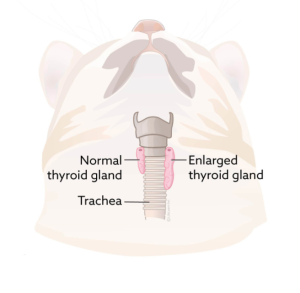83 The Cat That Ate And Ate But Never Gained Weight!
Melissa Veliz and Natasha Ninkovic
Student Learning Objectives
- Explain why a cat may eat a lot but still lose weight.
- Explain the importance of the thyroid.
- Describe the symptoms of hyperthyroidism.
Lesson
Cats have 2 thyroid glands in their neck, one on each side of their trachea or windpipe. These thyroid glands play very important roles such as regulating metabolism and they secrete two important hormones called T3 and T4 which affect every system in the body. In a hyperthyroid cat, the thyroid glands become bigger and start over producing the hormone T4 which increases the cat’s metabolism, making them hungrier. Common symptoms of hyperthyroidism are weight loss, excessive hunger, increased drinking, vomiting, a poor hair coat, and several others.

There are multiple reasons why an animal may lose weight. The five main reasons are lack of input, excessive output, loss of protein or nutrients, maldigestion, and malabsorption.Weight loss associated with hyperthyroidism falls under excessive output. The cat is burning up calories faster than it can consume them. A good metaphor for this is when your expenses outweigh your income. This is why a cat with hyperthyroidism may eat a lot but still lose weight.
Hyperthyroidism is typically seen in older cats. Most often in those over ten years old. The enlarged thyroid glands are caused by a non-cancerous(benign) tumor. The disease is diagnosed by taking blood from the cat and measuring the levels of thyroid hormone in the blood. High levels of the thyroid hormone indicate hyperthyroidism. There are multiple treatment options for this disease including surgery, radioactive iodine, oral medication, and a prescription diet. Cats normally do well with treatment.

The image above shows the weight loss and poor hair coat associated with hyperthyroidism.
Check out this short video to learn more:
Activity
Students will be divided into groups with 3 students in each group. There will be pretzels placed at the center of the table. One student tries to put as many pretzels as he/she can into a bowl while the other two students try to take pretzels away as fast as they can and place them in another bowl. They will have 5 minutes to complete this activity. The activity demonstrates that in cats with hyperthyroidism their body is using up more than what they can consume.

Assessment
Test out your new knowledge by taking this short quiz, you’ve got this!

